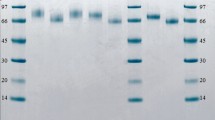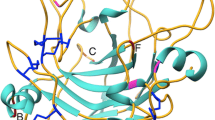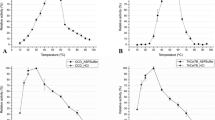Abstract
The filamentous fungi Trichoderma reesei and Penicillium funiculosum produce highly effective enzyme mixtures that degrade the cellulose and hemicellulose components of plant cell walls. Many fungal species produce a glycoside hydrolase family 7 (Cel7A) cellobiohydrolase, a class of enzymes that catalytically process from the reducing end of cellulose. A direct amino acid comparison of these two enzymes shows that they not only have high amino acid homology, but also contain analogous N-linked glycosylation sites on the catalytic domain. We have previously shown (Jeoh et al. in Biotechnol Biofuels, 1:10, 2008) that expression of T. reesei cellobiohydrolase I in a commonly used industrial expression host, Aspergillus niger var. awamori, results in an increase in the amount of N-linked glycosylation of the enzyme, which negatively affects crystalline cellulose degradation activity as well as thermal stability. This complementary study examines the significance of individual N-linked glycans on the surface of the catalytic domain of Cel7A cellobiohydrolases from T. reesei and P. funiculosum by genetically adding or removing N-linked glycosylation motifs using site directed mutagenesis. Modified enzymes, expressed in A. niger var. awamori, were tested for activity and thermal stability. It was concluded that N-linked glycans in peptide loops that form part of the active site tunnel have the greatest impact on both thermal stability and enzymatic activity on crystalline cellulose for both the T. reesei and P. funiculosum Cel7A enzymes. Specifically, for the Cel7A T. reesei enzyme expressed in A. niger var. awamori, removal of the N384 glycosylation site yields a mutant with 70% greater activity after 120 h compared to the heterologously expressed wild type T. reesei enzyme. In addition, similar activity improvements were found to be associated with the addition of a new glycosylation motif at N194 in P. funiculosum. This mutant also exhibits 70% greater activity after 120 h compared to the wild type P. funiculosum enzyme expressed in A. niger var. awamori. Overall, this study demonstrates that “tuning” enzyme glycosylation for expression from heterologous expression hosts is essential for generating engineered enzymes with optimal stability and activity.





Similar content being viewed by others
References
Adney WS et al (2003) Heterologous expression of Trichoderma reesei 1, 4-beta-d-glucan cellobiohydrolase (Cel 7A), in applications of enzymes to lignocellulosics. Amer Chemical Soc: Washington 40:3–437
Armand S et al (1997) A bifunctionalized fluorogenic tetrasaccharide as a substrate to study cellulases. J Biol Chem 272(5):2709
Chen CM et al (1987) Toward improved cellulases—targeted modifications of Trichoderma reesei exocellobiohydrolase-II using site specific mutagenesis. Abstracts of Papers of the American Chemical Society 194: 188–MBTD
Chen HZ, Hayn M, Esterbauer H (1993) Three forms of cellobiohydrolase-I from Trichoderma reesei. Biochem Mol Biol Int 30(5):901–910
Divne C et al (1994) The three-dimensional crystal structure of the catalytic core of cellobiohydrolase I from Trichoderma reesei. Science 265(5171):524–528
Doner LW, Irwin PL (1992) Assay of reducing end-groups in oligosaccharide homologues with 2,2′-bicinchoninate. Anal Biochem 202(1):50–53
Elshafei AM et al (1991) The Saccharification of corn stover by cellulase from Penicillium funiculosum. Bioresour Technol 35(1):73–80
Eriksen SH, Jensen B, Olsen J (1998) Effect of N-linked glycosylation on secretion, activity, and stability of alpha-amylase from Aspergillus oryzae. Current Microbiology 37(2):117–122
Eriksson T et al (2004) Heterogeneity of homologously expressed Hypocrea jecorina (Trichoderma reesei) Cel7B catalytic module. Eur J Biochem 271(7):1266–1276
Foreman PK et al (2003) Transcriptional regulation of biomass-degrading enzymes in the filamentous fungus Trichoderma reesei. J Biol Chem 278(34):31988–31997
Gaur R, Mishra S (1990) Cellulase activity at different sites in two fungal species, Trichoderma harzianum and Penicillium funiculosum. Acta botanica Indica 18(1):141–143
Grassick A et al (2003) Crystallization and preliminary crystallographic analysis of the catalytic domain cellobiohydrolase I from Talaromyces emersonii. Acta Crystallographica Section D-Biological Crystallography 59:1283–1284
Grassick A et al (2004) Three-dimensional structure of a thermostable native cellobiohydrolase, CBHIB, and molecular characterization of the cel7 gene from the filamentous fungus, Talaromyces emersonii. Eur J Biochem 271(22):4495–4506
Helbert W et al (2003) Fluorescent cellulose microfibrils as substrate for the detection of cellulase activity. Biomacromolecules 4(3):481–487
Hestrin S, Schram M (1954) Synthesis of cellulose by Acetobacter xylinum. Biochem J 58:345–352
Hui JPM et al (2001) Characterization of cellobiohydrolase I (Cel7A) glycoforms from extracts of Trichoderma reesei using capillary isoelectric focusing and electrospray mass spectrometry. Journal of Chromatography B-Analytical Technologies in the Biomedical and Life Sciences 752(2):349–368
Jeoh T et al (2008) Implications of cellobiohydrolase glycosylation for use in biomass conversion. Biotechnology for Biofuels 1(1):10
Krystynowicz A et al (2002) Factors affecting the yield and properties of bacterial cellulose. J Ind Microbiol Biotechnol 29(4):189–195
Lachke AH et al (1987) Strain selection criteria for Penicillium funiculosum in enzymatic hydrolysis of ligncellulosics. Biotechnol Lett 9(2):147–150
Laymon RA et al (1996) Cloning and expression of full-length Trichoderma reesei cellobiohydrolase I cDNAs in Escherichia coli. Appl Biochem Biotechnol 57–8:389–397
Manchanda AC, Jogdand VV, Karanth NG (1982) Studies on fermentation broth rheology of a Penicillium strain with cellulose as substrate. Journal of Chemical Technology and Biotechnology 32(6):660–665
Medve J, Stahlberg J, Tjerneld F (1994) Adsorption and synergism of cellobiohydrolase I and II of Trichoderma reesei during hydrolysis of microcrystalline cellulose. Biotechnol Bioeng 44:1064–1073
Medve J, Lee D, Tjerneld F (1998) Ion-exchange chromatographic purification and quantitative analysis of Trichoderma reesei cellulases cellobiohydrolase I, II and endoglucanase II by fast protein liquid chromatography. J Chromatogr A 808(1-2):153–165
Receveur V et al (2002) Dimension, shape, and conformational flexibility of a two domain fungal cellulase in solution probed by small angle X-ray scattering. J Biol Chem 277(43):40887–40892
Stals I et al (2004) Factors influencing glycosylation of Trichoderma reesei cellulases. I: postsecretorial changes of the O- and N-glycosylation pattern of Cel7A. Glycobiology 14(8):713–724
Taylor ME, Drickamer K (2003) Introduction to glycobiology. Oxford Universtiy Press, New York
Varrot A, Schulein M, Davies GJ (1999) Structural changes of the active site tunnel of Humicola insolens cellobiohydrolase, Cel6A, upon oligosaccharide binding. Biochemistry 38(28):8884–8891
Acknowledgments
This work was funded by the DOE Office of the Biomass Program.
Author information
Authors and Affiliations
Corresponding author
Rights and permissions
About this article
Cite this article
Adney, W.S., Jeoh, T., Beckham, G.T. et al. Probing the role of N-linked glycans in the stability and activity of fungal cellobiohydrolases by mutational analysis. Cellulose 16, 699–709 (2009). https://doi.org/10.1007/s10570-009-9305-1
Received:
Accepted:
Published:
Issue Date:
DOI: https://doi.org/10.1007/s10570-009-9305-1




